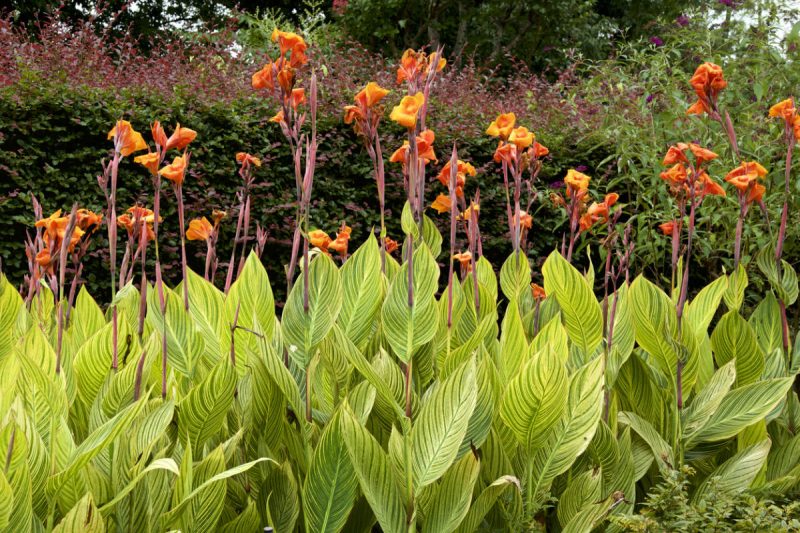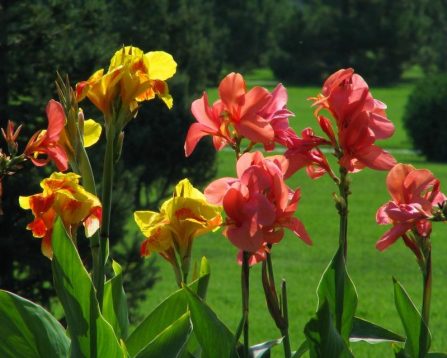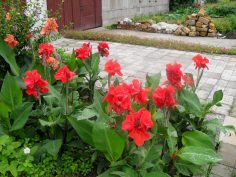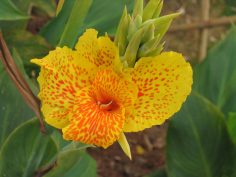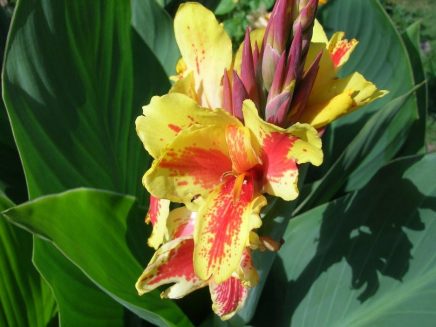Canna Flower is an exotic herb from the tropical climate of Asia and South America. In Europe, a decorative culture with large foliage of various shades and scarlet asymmetric flowers began to be cultivated in the 17th century, having won recognition and love from flower growers in a short time.
Material Content:
Varieties for growing in the garden and at home
The genus under its name unites more than 50 typical species, one of which is Indian Canna. On the basis of the variety, thanks to the painstaking work of breeders, many varieties differing in height and color were bred, combined in 3 groups:
- Cannes Crozie or French - the group consists of stunted plants up to 160 cm with flowers resembling gladioli. Graceful erect stems, crowned with beautiful, long inflorescences, are covered with leaves with a white coating of dark green or purple-bronze color. Popular varieties: raspberry red Livadia, America with purple leaves, President with bright red flowers, contrasting against a green background of decorative foliage.
- Orchid Cannes - plants of the group stand out with corrugated flowers at the edges, the shape of which is similar to Cattleya. Common varieties: bright orange with red touches Andenken en Pfitzer, lemon Suevia, yellow with red dots Richard Wallace.
- Small-flowered or leafy cannes are a group of tall plants that can grow up to 3 m. Small flowers with a diameter of up to 6 cm bloom against the background of decorative foliage. The most common cultivar is Durban with yellow flowers and pink-green-bronze leaves decorated with stripes.
How to grow cannons on a garden plot
The exotic flower is resistant to drought, harmful organisms and the only thing that complicates the cultivation of canna flowers in the garden is the poor tolerance of the winter colds characteristic of the Middle Strip.
Landing cannes in open ground
In order for the plant to take root in the garden and decorate it with beautiful flowering throughout the summer and until the autumn frosts, it should be wise to conduct pre-planting and planting operations:
- Definition of terms - the optimal time to start pre-plant preparation of the site falls in the late spring, when the threat of return frosts passes. Experienced gardeners do not plant tubers before the second decade of May due to sharp temperature changes, which can significantly slow down the growth rate of the cannon.
- Choosing a place - tropical flowers prefer protected from the wind and sunny areas.
- Soil preparation - Cannes for full development require light, loose and well-drained soil with a high fertility rate. When preparing the soil in the selected area, it is recommended to add peat, humus and coarse sand for digging.
- Planting - when the optimal planting time comes, planting pits 60 cm in diameter are dug up on the site. A “warming” litter 20 cm thick is created from the manure at the bottom, which is covered with a 25 cm soil layer. Then tubers are lowered and sprinkled with earth. If planting material has not yet sprouted, then the depth of incorporation should not exceed 9 cm. The distance between the holes and rows is 50 cm.
It is interesting: croton flower
How to care for flowers
Even an inexperienced grower can take care of the cannon in the open ground. It comes down to the following activities:
- Watering - watering the plants should be done regularly, but in moderation, without over-moistening the near-stem circle: this can cause the development of rot.
- Loosening and weeding - throughout the growing season, it is necessary to monitor the cleanliness and friability of the soil, weeding and loosening it if necessary.
- Fertilizing - Cannes should be fed three times per season with the help of granular mineral fertilizers, which include nitrogen, potassium and phosphorus.
- Pruning - during the entire flowering period, faded inflorescences are necessarily cut off.
- Hilling - when the plants bloom, it is necessary to high them up.
- Protection from pests - if caterpillars appear on shoots, they should be immediately treated with an insecticide. Flowers are quite resistant to disease.
Kanna at home
The representative of the tropical flora feels great as a pot culture.
Agrotechnics of cultivation and care
In order for the plant to please the eye with beautiful flowers and healthy decorative leaves at home, no special effort is required. Caring for a cannon in a pot or tub is much simpler than in open ground. All agricultural cultivation techniques come down to providing good lighting, systematic watering and wiping of leaf plates with a wet sponge.
The nuances of care after flowering
When the plant fades, the following actions must be taken:
- Homemade canna - leaves are cut to a height of 15 cm, and the container with the flower moves to a cool place with a temperature of 10-15 ° C, but not lower.
- Garden canna - before the frost, plants are spudding. When they pass, the rhizomes are removed together with a lump of earth and transferred to storage.
Read also:Roly wet flower
Plant propagation
Cannes can be propagated by generative and vegetative methods. However, the first method does not guarantee the preservation of varietal characters. If the grower is not keen on selection, then it is worthwhile to dwell on a more productive and simpler technique - dividing the rhizome.
Tubers are removed from the soil at the beginning of spring and divided in such a way that each split has a large kidney and several underdeveloped ones. Places of damage are sprinkled with crushed coal.Rhizomes fit tightly in a greenhouse tank with sand so that the kidneys are horizontal. When leafy ones appear, the plates are planted in separate pots, from which they can be planted in the garden when the optimum time is right.
It is interesting:Cyclomania flower: care and reproduction
Wintering flower
After the first frosts, plants are removed from the soil and moved together with an earthen lump to a place of future storage:
- Cool storeroom with diffused light - rhizomes are placed in wooden containers, where they are covered with peat, sand and sawdust. During storage, the bulbs are systematically examined for the presence of fungal infections. When foci of pathogens are identified, the affected areas are removed, and healthy planting material is treated with iodine. You should also maintain moderate humidity in the storage room and avoid sudden temperature changes.
- Refrigerator - in the absence of a pantry or other similar premises, rhizomes can be stored in a refrigerator in the vegetable compartment. Pre-planting material is cleaned of soil residues, kept for 24 hours in a solution of manganese for disinfection, and then dried and wrapped individually in paper. During storage, the bulbs are checked so that they are not affected by rot, which must be combated immediately, removing the affected areas and treating the healthy part with a fungicide or other disinfectant.
So, to grow a canna that will decorate a garden or apartment during the warm season is quite simple, if you do not forget about the basic rules for caring for a decorative flower.





